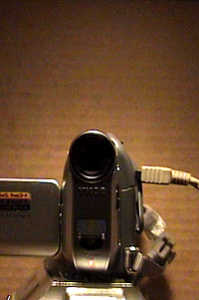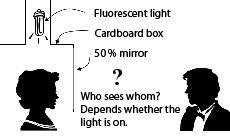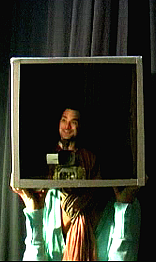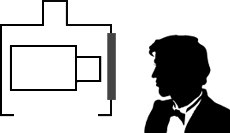Abstract

“One-way” mirrors are explored in an entertaining, hands-on experiment.
Portable
Yes
Principles Illustrated
JNR SCI, SCI 1.4, PHYS 1.3, PHYS 2.3, SCI 2.9, SCI 3.6
Reversibility of Light Rays

“One-way mirrors,” also sometimes called a “two-way mirrors”, do not prevent light from traveling in one direction. A one-way mirror would be inconsistent with reversibility of light rays.
To make a “one way mirror” one mounts between two rooms a thinly-silvered mirror that reflects some light and transmits the rest. One room is dark and the other is brightly lit. Rays can go either direction, but since there is very little light in the dark room very few rays go from the dark room to the bright room.
Camera inside the box with lights in the box sees its mirror image.
 On the other hand, there are lots of rays going from the bright room to the dark room. How well the one way mirror works really depends on the ratio of the light intensities. It is not crucial what fraction of the light is transmitted and reflected and long as a significant fraction is reflected and a significant fraction is transmitted.
On the other hand, there are lots of rays going from the bright room to the dark room. How well the one way mirror works really depends on the ratio of the light intensities. It is not crucial what fraction of the light is transmitted and reflected and long as a significant fraction is reflected and a significant fraction is transmitted.
NCEA & Science Curriculum
JNR SCI, SCI 1.4, PHYS 1.3, PHYS 2.3, SCI 2.9, SCI 3.6
Instructions
A student or teacher wears the box with the half silvered mirror. When the inside of the box is dark but the classroom is bright, the occupant of the box can see out but others cannot see the occupant. When the room lights are dimmed and a fluorescent light is shined in the top hole of the box the situation is reversed. Now the occupant of the box sees his own reflection only and the students in the classroom can see the occupant of the box clearly.
Students like this one, particularly if the teacher is the occupant of the box.
Three short videos below show the view with student or camera in the box, lights inside or outside the box.
Videos
Student in the box (right-click and save as, m4v file, 1.7 MB): Student_in_Box
Camera in the box (right-click and save as, m4v file, 400 KB): Camera_In_Box
Taking off the box (right-click and save as, m4v file, 800 KB): Taking_off_the_box
Student in box, camera (or observer) outside.
 The camera sees the student if the box is lit inside and the room is dark. See photo at top of page.
The camera sees the student if the box is lit inside and the room is dark. See photo at top of page.- Camera sees its own reflection if the room is illuminated and the interior of the box is dark as in photo at right.
- Student can see out of the box is dark and the room is illuminated.
- Student sees her/his own reflection if the interior of the box is illuminated and the room is dark.
- Student In The Box.mp4 (3.3 MB)
Camera (or observer) in box, student outside box.
 The camera sees the student if the interior of the box is dark and the room is illuminated.
The camera sees the student if the interior of the box is dark and the room is illuminated.- Camera sees its own reflection if the room is dark and the interior of the box is illuminated.
- Student can see the camera if the interior of the box is illuminated and the room is dark.
- Student sees her/his own reflection if the interior of the box is dark and the room is illuminated.
- Camera In The Box.mp4 (0.5 MB)
Safety
If you make one of these mirror boxes, be sure to use very sturdy tempered glass.
We recommend a fluorescent or LED bulb to avoid burn injuries. Do NOT use an incandescent bulb as it will get too hot. Use a lamp that does not allow the bulb to extend into the box. You do not want the bulb to come into contact with the occupant of the box! Be careful not to break the bulb.
Individual teachers are responsible for safety in their own classes. Even familiar demonstrations should be practised and safety-checked by individual teachers before they are used in a classroom.
Related Resources
Candle under water
Teaching Resources
Would you like to contribute lesson suggestions? Contact us.
Credits
This teaching resource was developed with support from
The MacDiarmid Institute
Faculty of Science, Victoria University of Wellington
School of Chemical and Physical Sciences, Victoria University of Wellington